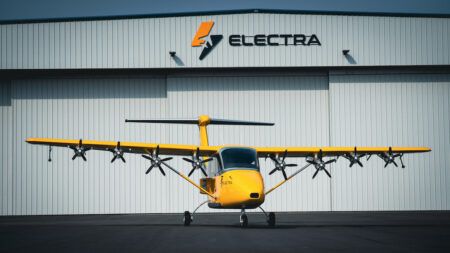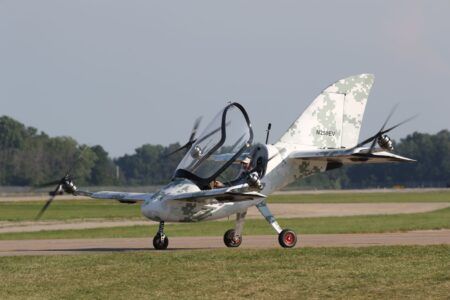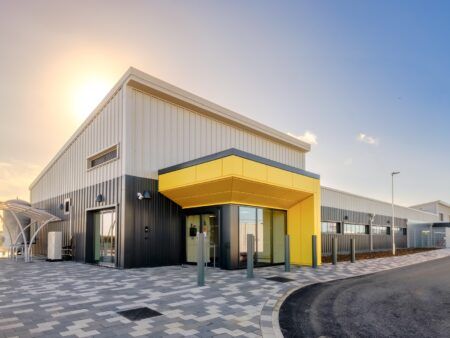The motors that will power NASA’s first fully-electric X-plane to the skies have begun endurance testing on the ground.
Using a teststand called Airvolt, engineers at NASA’s Armstrong Flight Research Center in California are testing the motors and their motor controllers, collecting data to help verify that the experimental electric propulsion system is ready to be deemed flightworthy.
If successful, the motors, along with their controllers and propellers, will be integrated into what will become NASA’s first all-electric experimental airplane, or X-plane – the X-57 Maxwell.
X-plane modifications
NASA’s X-57 Maxwell will be powered by a battery system that consists of 16 battery modules. The system will comprise 800 pounds of the aircraft’s total weight. Credits: NASA
The X-57 is a highly modified Tecnam P2006T aircraft with the traditional combustion engines and wing replaced with an experimental distributed electric propulsion system. The test aircraft is intended to demonstrate the potential of electric propulsion to achieve high efficiency and reduced carbon emissions, and lower the operating costs for aircraft.
The X-plane, which will be NASA’s first manned experimental airplane in two decades, will undergo several modifications, conducting flight tests with each stage.
Before such an experimental system can be used for flight, however, it needs to undergo extensive testing to validate its safety and functionality in order to be deemed flightworthy according to NASA’s flight qualification process.
“We want to confirm that the motor system is as safe as possible before X-57 begins flight testing. The testing is important at this stage because X-57 is a manned test research project, meaning the aircraft will have a pilot on board,” said Airvolt Lead Systems Engineer Yohan Lin.
“Previous electric propulsion projects have been conducted using unmanned aircraft and at a smaller scale, but with a pilot on board, the level of risk is higher.”
NASA Armstrong is receiving a total of five JM-X57 cruise motors, designed and built by Joby Aviation in Santa Cruz, California. The team will use two of these electric motors in place of the standard Rotax 912 S3 piston engines for the first flight tests of the X-57’s first modification, known as Mod II.
While additional motors are being tested as spares, the aim is to use the same two motors from Mod II as the primary propulsion system for the aircraft’s later modifications, according to X-57 principal investigator Sean Clarke.
“The two motors that we fly in Mod II, ideally, will be the same two that we take and put on the following Mod III vehicle, which will see the standard Tecnam wing replaced with a thinner, high-aspect ratio wing, and we’ll also see the relocation of those cruise motors to the wing tips,” explained Clarke.
“After that, we’ll again evaluate the status of the motors, and go with the best option for the wingtip cruise motors for Mod IV, which will add twelve smaller ‘high-lift’ motors along the new wing’s leading edge.”
Motor inspections
Data obtained from Airvolt testing is used by engineers to analyze how efficient the electric propulsion system is, and also whether the motor components are able to operate nominally while remaining within high- and low-temperature limits, set by the research team. Credits: NASA / Lauren Hughes
The fifth motor will undergo testing on Airvolt at its full operational capability, and will then be taken apart to have its components inspected as part of what’s called a “destructive inspection”. The state of the bearings, rotor and magnets will be observed and analyzed to see how healthy they are. This provides more insight about the motor than can be observed by inspecting the exterior, and NASA researchers will be able to learn more about the motor’s performance and safety limits.
The cruise motor tests on Airvolt will help researchers better understand the power and efficiency of the cruise motors, in addition to making certain that the motor system will stay within safe operating limits during a flight.
The tests are being conducted using an automated procedure tool called Procedure Integrated Development Environment, or PRIDE, developed for NASA by Houston-based TracLabs. The tool uses a given test profile and sends commands to the cruise motor controller, which in turn tells the motor how fast to spin.
Vibration and thermal analysis
The Airvolt stand is instrumented to measure system voltage, current, temperature, vibration, torque and thrust. This data is used by engineers to analyze not only how efficient the electric propulsion system is, but whether the motor components can operate while remaining within high and low temperature limits, set by the research team.
Vibration and thermal analysis are both important elements to the overall motor endurance testing on the X-57 cruise motors. The motor testing includes exposing the motor to various levels of vibration and temperatures. To do this, the motor is exposed to both its nominal and maximum operating temperatures. Engineers will then analyze the motor’s ability to remain operational through those conditions.
Data is also being gathered to better understand the torque and thrust produced by the motors. This data is obtained by testing the motor and the motor controller at various power and torque levels, and exposing it to various amounts of stress for specific amounts of time.
These elements are critical in one of X-57’s primary roles as a pathfinder for electric propulsion – working to identify and establish airworthiness standards for future electric flight.
Developing standards
Since distributed electric propulsion is an experimental technology, no airworthiness standards currently exist for the use of fully electric motors in flight. One of the primary objectives of Airvolt testing, and of future X-57 research flights, is to help the flight certification community including the FAA, the American Society for Testing and Materials, or ASTM, and others, identify and establish these standards for the future.
The data gathered by these efforts will be provided to the certification community to be used in establishing standards for the future of electric aviation.
For Airvolt testing, this includes providing lessons learned through the evaluation of experimental components and any issues associated with them, such as electro-magnetic interference, or EMI. In the case of X-57, engineers are analyzing the effect of EMI on these components, and providing multi-dimensional fixes necessary to make them more resilient.
“Learning these lessons now on the ground provides the benefit of preventing potentially costly errors later on in flight,” said X-57 project manager Tom Rigney. “An important aspect of X-57 is that it is advancing electric propulsion system technologies and acquiring airworthiness test data from Airvolt, other ground testing, and eventually flight testing, that will be provided to the certification community to help establish new regulations in the future.”
The completion of Airvolt testing of the flight cruise motors will mark an essential part of the X-57 project that, if successful, will assure that the motors will meet the requirements that are necessary to keep the manned X-plane operational throughout the entire flight program including Mod II and beyond, according to Rigney.
“Mod II will require the complex integration and flight testing of newly-developed, high-electrical energy components that include motors, controllers and batteries. By putting the motors through a rigorous ground test program using Airvolt, we will be ensured that the motors will work effectively and safely when all the Mod II components are finally integrated and flight tested on X-57.”





